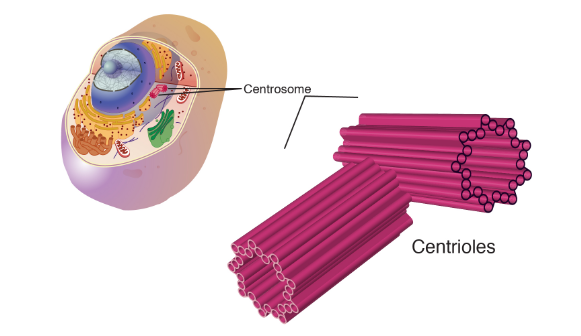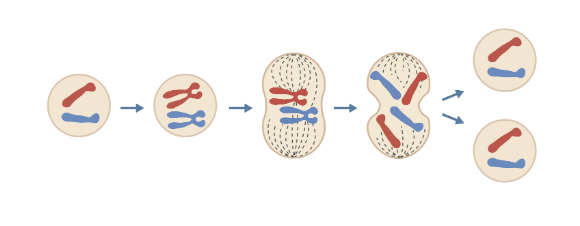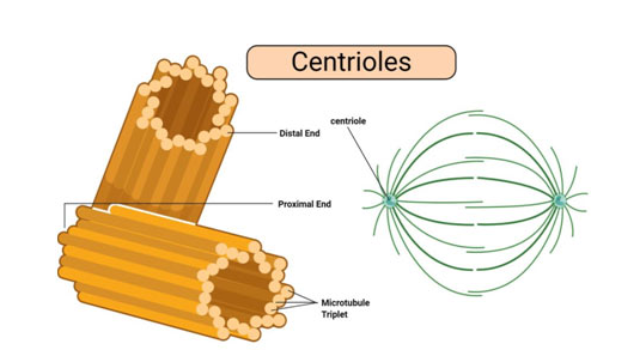Cells
- Centrioles are a pair of cylindrical structured cell organelles found near the nucleus of animal cells and some plants cells that assist in cell division.
- Centrioles are self-replicating organelles located in the centrosome near the nuclear membrane present in the nucleus. The centrosome is present in the cell’s cytoplasm, containing these centrioles. Hence, the centrioles are inactive and do not aid at the beginning of mitosis.
- Meiosis and mitosis are stages where a cell divides into two and four daughter cells, respectively. There are four stages to meiotic cell division: Interphase, Prophase, Anaphase, and Telophase. During these phases, the centrioles are duplicates, although the process is still unknown.
- They move towards opposite poles in the cell, producing mitotic spindles that attach to the centromeres of condensed chromosomes. These chromosomes are pulled apart by the spindles separating the chromosomes, leading to cell cytokinesis (cell division from cytoplasm), forming two daughter cells.
- Understanding the importance of centrioles’ working is crucial since if any mistakes occur during this stage, it will lead to an abnormal cell division, causing multiple medical issues.
At the beginning
- Centrioles were discovered by Van Beneden and Boveri. They initially viewed mitotic spindles at the poles of a cell, naming them polar corpuscles. Later they found that these spindles did not die after mitosis but continued to stay in the cell throughout. During the interphase of meiosis, a pair of centrioles lay perpendicular to each other in their inactive state.
- After the initiation of cell division, these centrioles begin to separate and move towards opposite poles radiating spindles. Once the chromosomes are released from the nucleus, the spindle attaches itself to the centromeres of chromosomes, aligning them equally at the center of the cell, ready for cell division.
- At mitosis, the single centriole duplicates and forms a pair of centrioles so that each daughter cell will have a pair of centrioles. Van Benden and Boveri considered centrioles as a division organ’. However, higher plant cells did not have centrioles for cell division. Therefore, centrioles were no longer considered a ‘division organ’ but an essential organelle that assists in efficient cell division.
Functions
- At the initiation of meiosis, the genetic material starts to replicate, and the centrioles duplicate themselves and move apart towards the opposite poles. These centrioles contain microtubules that radiate spindles, which interact with the chromosomes, causing them to align at the cell’s equator.
- A chromosome consists of two chromatids attached to the centromere with the help of a kinetochore. The spindles attach to these kinetochores, thus separating the chromosomes into daughter chromosomes. They are then pulled towards opposite poles, moving away from each other, and are aligned to make the cell division efficient.
- Finally, these daughter chromosomes are detached from the spindles to converge inside, forming a nucleus of their own. This process leads to the initiation of cytokinesis, forming two daughter cells.
- Another role of centrioles is that they can interconvert into basal bodies, which are specialised microtubules to form cilia and flagella. Cilia and flagella are cellular extensions found on a cell’s surface responsible for allowing the flow of materials through the tracts, such as windpipes.
- These are modified centrioles, and based on the movement of the substances in the tracts, they bend accordingly. Some of these cell extensions aid in sensing their surrounding conditions.
Significance
- Proper functioning of the meiotic spindle is required for the successful transportation of chromosomes.
- If the meiotic spindle is not wholly developed, the chromosomes are not separated equally, affecting cell division. This could pose a serious health risk if the cell division occurs under unfavorable conditions, causing abnormal daughter cells to form.
- Abnormal mutations and other diseases can also arise from the incomplete functioning of centrioles, such as cancer and microcephaly.
- In plant cells, the centrioles are not required for their cell division. However, without the centrioles, the meiosis will become inefficient and prone to errors for animal cells.
- During meiosis, the centrioles move towards opposite poles inside the cell. While spindles do not attach to the remaining chromosomes, they assist cell division by pushing the cell’s plasma membrane to their opposite sides.
internal links:
Tags:
life scienceOther Articles
Next
Previous
April 28, 2022









